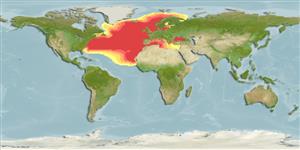Classification / Names
Common names from other countries
Main reference
Size / Weight / Age
Max length : 122 cm TL male/unsexed; (Ref. 88166); 133.0 cm TL (female); common length : 35.0 cm TL male/unsexed; (Ref. 6125); common length :50 cm TL (female); max. published weight: 6.6 kg (Ref. 39903); max. published weight: 6.6 kg; max. reported age: 88 years (Ref. 72468)
Length at first maturity
Lm ?, range 45 - 65 cm
Environment
Marine; freshwater; brackish; demersal; catadromous (Ref. 51243); depth range 0 - 700 m (Ref. 54218)
Climate / Range
Temperate; 4°C - 20°C (Ref. 2059), preferred ?; 75°N - 8°N, 82°W - 45°E (Ref. 42249)
Distribution
Atlantic Ocean: Atlantic coast from Scandinavia to Morocco; Baltic, Black and Mediterranean Seas; rivers of North Atlantic, Baltic and Mediterranean seas (Ref. 172, Ref. 51442). Continuous introductions to Asia and South and Central America. Spawning area in western Atlantic (Sargasso Sea). At least one country reports adverse ecological impact after introduction. Recent genomic DNA studies show that the European eel exhibits isolation by distance, implying that non-random mating and restricted gene flow among eels from different location exists (Ref. 43723). The existence of 3 genetically distinct sub-populations is suggested: a Northern European subpopulation (consisting mainly of the Icelandic stocks); a Western European subpopulation (including the Baltic, the Mediterranean and Black Sea); a Southern sub-population (including stocks of Morocco) (Ref. 43723, 89139). International trade restricted (CITES Appendix II, since 13.5.2009).
Countries | FAO areas | Ecosystems | Occurrences | Introductions
Short description
Dorsal
spines
(total): 0;
Anal
spines: 0;
Vertebrae: 110 - 120. Elongated, anguilliform body (Ref. 51442), cylindrical anteriorly, somewhat compressed posteriorly (Ref. 6125). Lower jaw slightly longer and projecting (Ref. 6125, Ref. 51442). Gill openings small and vertical, restricted to the sides (Ref. 6125). Elongated dorsal and anal fins, confluent with caudal fin (Ref. 6125, Ref. 51442), forming one unique fin from the anus to the middle of the back with minimum 500 soft rays (Ref. 40476). Dorsal fin origin far behind pectoral fins; anal fin origin slightly behind anus, well back from origin of dorsal fin (Ref. 6125). Pelvic fins absent (Ref. 2196, Ref. 51442). Greenbrown colored (Ref. 51442).
IUCN Red List Status (Ref. 115185)
Threat to humans
Harmless
Human uses
Fisheries: commercial; aquaculture: commercial; gamefish: yes
Tools
Special reports
Download XML
Internet sources
Estimates of some properties based on models
Phylogenetic diversity index
PD50 = 0.5000 many relatives (e.g. carps) 0.5 - 2.0 few relatives (e.g. lungfishes)
Trophic Level
3.6 ±0.3 se; Based on diet studies.
Resilience
Low, minimum population doubling time 4.5 - 14 years (K=0.1; tm=6-30; tmax=85(?))
Vulnerability
High vulnerability (64 of 100)
Price category
